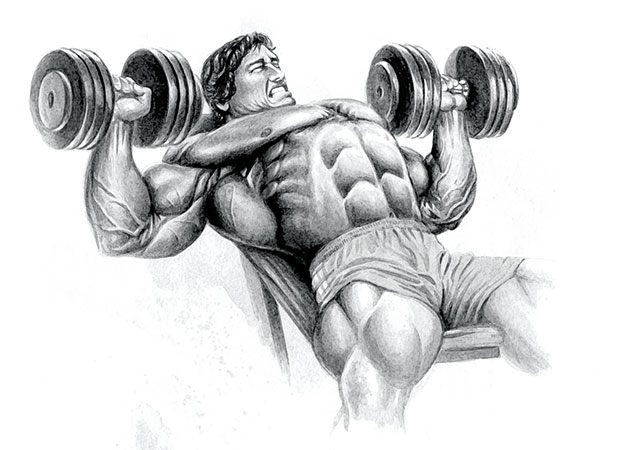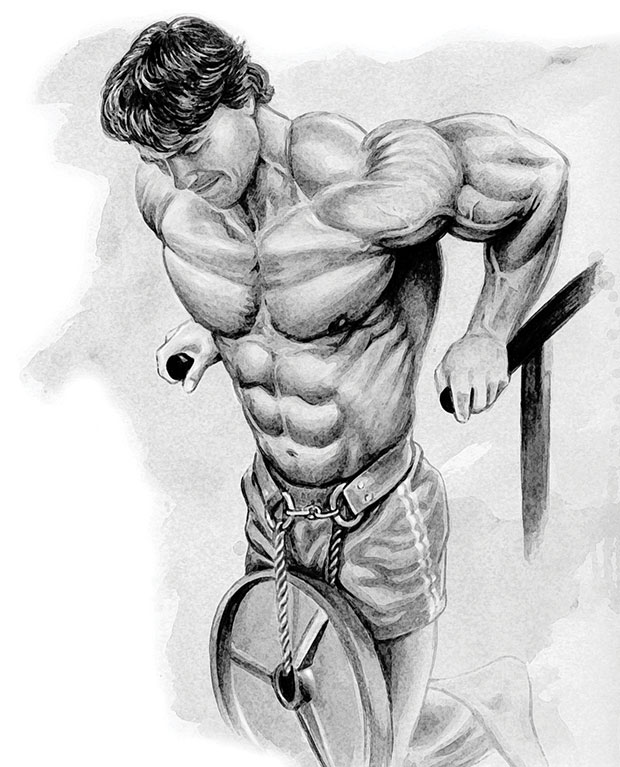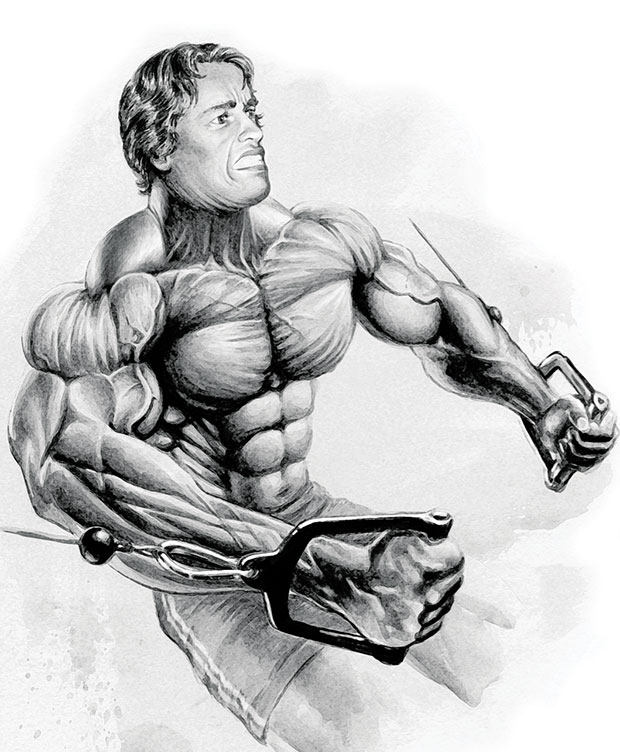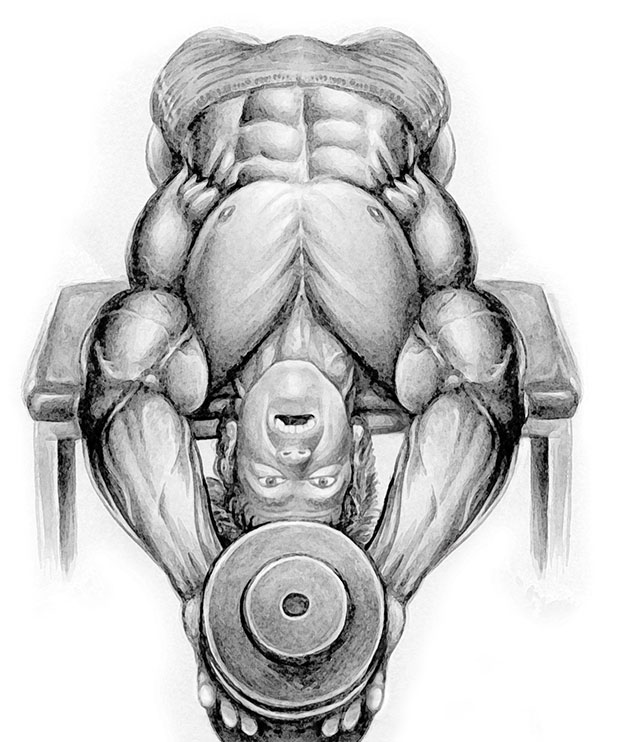BUILDING THAT TERRIFIC ARNOLD CHEST

How Arnold Schwarzenegger Developed
His Outstanding Pecs
AN EVOLUTION OF KNOWLEDGE
When Arnold set out to update and revise his Encyclopedia of Modern Bodybuilding, he faced something of a dilemma. The first version, published in 1985, essentially detailed how he had learned to train in the 1960s and what he had learned during his career to that point. But he was determined that the updated version, written in 1998, would showcase all the new information on training and diet that had been so rapidly evolving over that period of 13 years. But how could he impart that information without making it seem that he and his contemporaries had been doing so much wrong in years past?
The answer, of course, was simply to point out that in this age of science and information knowledge about bodybuilding had continued to develop along with everything else and what readers would learn in the updated book represented an evolution in information building upon the foundation of had been discovered in the past.
This is all a part of modern life. Everything from cars, airplanes, electronics, cameras, computers and most everything else develops and improves over time. The same is true when it comes to knowledge of how best to aesthetically develop all the muscles of the body with progressive resistance training.

BUT SOME STAYS THE SAME
But one area in Arnold’s New Encyclopedia of Modern Bodybuilding that required little revision was that of chest training. Yes, Arnold pointed out that the modern training cycle calls for shorter and fewer workouts, more intensity, and lots of time for rest and recuperation compared to what he had learned as a young man in Austria and Germany. But the basic exercises and training techniques he had always used to work his chest were essentially the same in 1998—and today as well—as they had been in 1968.
THE BASICS OF TRAINING CHEST
The pectorals arise from the sternum and attach to the shoulders. Their function is to pull the shoulders and the entire shoulder girdle forward and towards the centre. The chest muscles don’t attach to or have anything to do with the contraction of the muscles of the arms.
There are basically two kinds of movements for working the pecs: some kind of two-joint movement (presses) and some kind of isolation movement (flyes). One special case is dumbbell pullovers, which are a kind of vertical rather than horizontal flying movement.

THE EXERCISES
FLAT BARBELL BENCH PRESS
Presses can be done lying flat, on an incline, or on a decline. Barbell presses allow you to use the most weight, and doing presses lying flat involves the maximum amount of pectoral muscle during the lift.
Execution: Lie on a flat bench with a barbell on the rack above you. Grasp the bar with your hands somewhat more than shoulder width apart. If you hands are too close together, you end up doing a triceps press rather than working the chest.
Lift the bar at arm’s length above you (use a spotter if you have any doubt as to whether you can handle the weight safely). Lower the bar under control until it just touches your sternum. Pause for a moment, then press the bar back up to the starting position.
Note: If you bounce the bar on your body rather than pausing, you create a reflex response that helps you lift the weight. But your aim is weight training, not weight lifting, so pausing at the bottom will create the maximum muscle response to your workouts.

INCLINE DUMBBELL PRESS
Pressing on an incline bench targets the upper area of the pectorals. Working with dumbbells instead of a barbell forces each side of the body to work independently. This also allows you to lift the weights more in a circular arc, which puts more emphasis on chest involvement and less on effort by the triceps.
Execution: Lie on an incline bench and hold dumbbells at arm’s length above you, palms facing forward. Lower the weights under control, following a circular path rather than dropping them straight down. Stop when you feel the pectorals at full stretch, pause, and then press the dumbbells back to the starting position following that same circular path.
Note: Concentrate on feeling the pecs stretch and contract during the exercise, and keep the involvement of the triceps (straightening of the arm) to the minimum.

DIPS
Dips are essentially another way of doing decline presses and target the lower area of the pectoral muscles.
Execution: Position yourself between dip bars, arms extended, and lean forward to target the pecs rather than the triceps. Bend your arms and lower your body, keeping the elbows out—again to put the effort on the chest rather than the arms. At the bottom of the movement, with the chest muscles stretched, pause and then press back up to the starting position.
Dips can be done using your body weight or with added weight to create more resistance (which is what Arnold preferred to do). You can add weight by holding a dumbbell between your legs, using a belt to which a weight can be attached, or using dip equipment that includes a cable attached to a belt.
Note: When you keep your body more upright, your dips become more of a triceps exercise. Bending forward and keeping your elbows out allows for more targeting of the pecs.

CABLE CROSSOVERS
Cable crossovers are a flying movement using cables and pulleys. This exercise allows for a longer range of motion of the pecs than working with dumbbells and a greater peak contraction. It’s also much safer than dumbbell flyes, which can result in joint or muscle injury if done incorrectly.
Execution: Grab hold of handles attached to cables and pulleys on either side. Bend slightly forward and extend your arms out to either side, palms forward. Bend your arms slightly and keep them bent at the same angle throughout the exercise.
Bring the handles together in front of you in a big hugging motion, feeling the chest muscles contract and not using your arms. Squeeze your chest muscle together; you can even cross your hands over somewhat to get a longer range of motion. After pausing at the top, bring your hands back under control to the starting position.
Note: This is an isolation refinement exercise. The point is extending range of motion and getting a full contraction of the pecs. It’s not a power or max building movement, so work for strictness and control rather than trying to use too much resistance.

DUMBBELL PULLOVERS
Flyes involve stretching the pecs with weights extending out to the side. With pullovers, you stretch the chest by moving the weight back over your head.
Execution: Lie across a bench, head hanging off the edge, and hold a dumbbell at arm’s length above you. Keeping your arms extended, lower the weight in a wide arc down and behind your head until you feel the chest muscles fully stretched. Pause and then bring the weight back to the starting position, keeping the arms straight throughout the movement.
Note: To keep intensity at the maximum, drop your hips slowly as you lower the weight, increasing range of motion.

